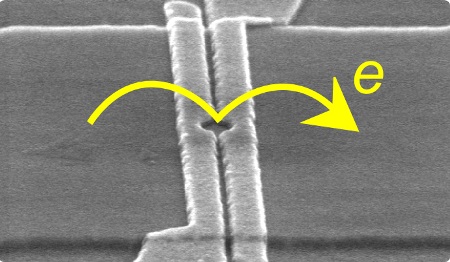A team of researchers from the University of Cambridge and National Physical Laboratory (NPL) has achieved a significant progress in utilizing nano-devices to generate well-defined electrical currents.
 Scanning electron microscope image of the electron pump. The arrow shows the direction of electron pumping. The hole in the middle of the electrical control gates where the electrons are trapped is ~0.0001 mm across.
Scanning electron microscope image of the electron pump. The arrow shows the direction of electron pumping. The hole in the middle of the electrical control gates where the electrons are trapped is ~0.0001 mm across.
The researchers achieved the advancement when they investigated with accurate form of voltage pulses that manipulate the confinement and ejection of electrons. By altering the voltage slowly when confining electrons, and then more quickly while ejecting them, the scientists were able to accelerate the overall pumping rate while maintaining the accuracy intact. The study results have been published in the Nature Communications journal.
The researchers utilized a quantum dot, a nano-sized semiconductor device, to pump electrons into a circuit. The electron pump is a small electrostatic trap with a width below 0.0001 mm. The researchers control the quantum dot’s shape by applying voltages to nearby electrodes.
During the study, the scientists filled the quantum dot with electrons and then increased its energy. They then reverted back all but one of the electrons into the source lead using the back tunneling process, thus trapping just one electron in the dot. They then titled the dot to eject that one electron into the output lead. By rapidly repeating these steps, the researchers were able to produce an accurate current based on the charge on each electron and the rate of repetition.
The quantum dot generates electrical current by controlling each electron at a very high speed. Thus, this method may redefine the electrical current, the ampere that depends on mechanical force measurement on current-carrying wires. Using this technique, the researchers achieved a pumping rate of nearly a billion electrons per second, a 300-fold quicker than the rate achieved by an accurate electron pump demonstrated at the National Institute of Standards and Technology in 1996.
Even though the resulting current was just 150 pA, the researchers were able to perform accurate current measurement of one part-per-million, corroborating the accuracy of the electron pump at this level.